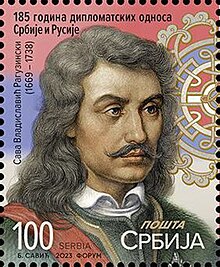Sava Vladislavich
Sava Vladislavich | |
|---|---|
 Vladislavich on a 2023 stamp of Serbia | |
| Born | 16 January 1669 |
| Died | 17 June 1738 (aged 69) |
| Occupation(s) | Diplomat, trader |
Count Sava Lukich Vladislavich-Raguzinsky (
Background
Vladislavich was born in 1669, in the village of
Russian service
A commercial project brought the young merchant to
At the time Russia did not have access to the warm sea, and the ports in the
The Battle of Poltava
On 8 July 1708 the Battle of Poltava took place. It is alleged that Vladislavich, with his skill, de facto saved Peter in a conflict with King Charles XII of Sweden. The Swedes agreed with the Turks to attack Russia on two fronts, but Vladislavich found out about it from trusted intelligence sources and told Peter once he arrived from Constantinople in 1708. The Russian tsar was furious because the conflict had already begun to brew. The count asked him for money to bribe the Turks, who had already been bribed by the Swedes. When asked by Peter what he would do if he failed, Vladislavich answered that the only pledge he could offer was his head. Peter accepted the proposal and the matter was settled.[2]
The Balkans
The "Illyrian Count" (as Vladislavich liked to style himself) maintained trade contacts with fellow Serbs and was under the impression that they would rise in revolt against the Sultan as soon as the Tsar invaded the
In the year 1711 Mikhail Miloradovich came to Montenegro, to the great misfortune of the Monastery and of Montenegro.... [for Vizir Kiuprili in 1714] razed Montenegro and destroyed the church and the Monastery.
Venice
From 1716 to 1722, Vladislavich resided in

Among many tasks, Sava Vladislavich had, politically, the most important task for Russia, and that is the establishment of a
Treaty of Kyakhta
Vladislavich was made ambassador plenipotentiary to China on 18 June 1725.
Viewing the commonly agreed border as an "everlasting demarcation line between the two empires",
Writings
In 1722, Sava Vladislavich published his most famous work, a translation in Russian of
Legacy
According to Serbian poet and diplomat Jovan Dučić, descendant of Sava's either half-brother or first cousin Duka (whence the eponymic family name Dučić), "Sava Vladislavich occupied a distinguished position among Russian diplomats in the eighteenth century. During two and a half decades, he took part in all important events of the Russian empire as a legate of the Czar (Peter the Great) and Czarina (Catherine I of Russia)."[7]
The fortress of Troitsko-Savsk (now Kyakhta) was named after him at the time when he was negotiating a second treaty in 1727 between Russia and China. The historian Marie–Janine Calic describes him as an "intercultural mediator par excellence".[8][9]
See also
- Serbs in Russia
- Matija Zmajević
- Semyon Zorich
- Peter Tekeli
- Georgi Emmanuel
- Simeon Piščević
- Jovan Albanez
- Jovan Šević
- Anto Gvozdenović
- Mikhail Miloradovich
- Ilya Duka
- Dmitry Horvat
- Marko Voinovich
- Marko Ivelich
References
- ^ a b c "Diplomata Petra I Velikog Sava Vladislavić Raguzinski". rts.rs (in Serbian). Radio and Television of Serbia. 7 July 2021.
- ^ a b c "SVETSKI a NAŠ: Srpski grof koji je osvojio ruskog cara, turskog sultana, papu i italijanskog kompozitora! | Serbiantimes.info". SerbianTimes. 20 October 2020.
- ^ Serbia, RTS, Radio televizija Srbije, Radio Television of. "Зашто је Вивалди посветио оперу грофу из Херцеговине". www.rts.rs. Retrieved 15 October 2020.
{{cite web}}: CS1 maint: multiple names: authors list (link) - ISBN 9781684172009.
- ISBN 0-7656-0661-5. Page 169.
- ISBN 0-674-01684-X. Page 250.
- ^ Jovan Dučić, Grof Sava Vladislavić: jedan Srbin diplomat na dvoru Petra Velikog i Katarine I, Beograd-Pitsburg 1942
- ISBN 9789004435445.
- ISBN 9780674983922.
This article incorporates text from a publication now in the public domain: Brockhaus and Efron Encyclopedic Dictionary (in Russian). 1906. {{cite encyclopedia}}: Missing or empty |title= (help)
Bibliography
- Orbini, Mauro (1601). Il Regno de gli Slavi hoggi corrottamente detti Schiavoni. Pesaro: Apresso Girolamo Concordia.
- Орбин, Мавро (1968). Краљевство Словена. Београд: Српска књижевна задруга.
- Milovan Djilas, Njegoš: Poet, Prince, Bishop, Introduction and Translation by Michael B. Petrovich; Preface by William Jovanovich (Harcourt, Brace, Jovanovich, New York, 1966).
Further reading
- Tsiganovich, D. (2006). "Savva Lukich Vladislavich-Raguzinsky" (in Russian).
